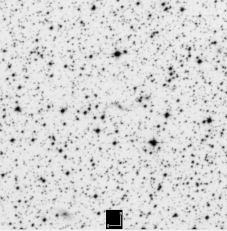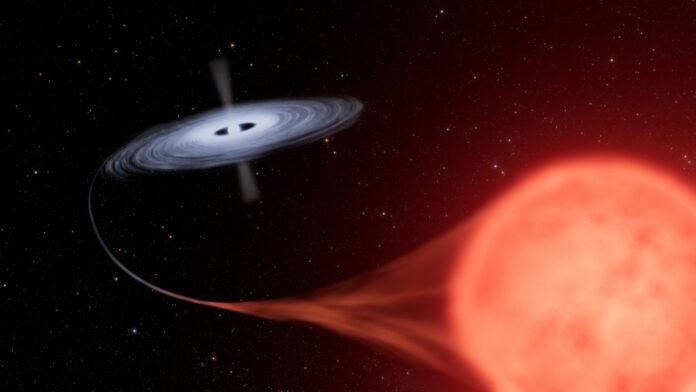Thermonuclear detonations on white dwarf stars are “lithium factories,” according to a gamma-ray signal that is the first hard evidence that these explosions are creating the lithium used in our electronics.
Lithium was the heaviest element to be produced in the Big Bang, which also generated hydrogen and helium. Today, lithium is an integral part of our modern technology, utilized in lithium-ion batteries that power everything from smartphones to electric vehicles.
Yet lithium is central to one of the great mysteries of the cosmos. As the universe cooled during the immediate aftermath of the Big Bang, the first elements were forged. Hydrogen made up about three-quarters of those elements, and helium about a quarter. Then there was lithium, which was but a trace amount. Yet when astronomers look at the stars, they find that most of them show evidence for even less lithium in their composition than we’d expect from the amount produced in the Big Bang.
Astronomers have explained this by showing how lithium can be dragged down inside a star from its outer layers and destroyed. Yet some stars go against the grain — younger generations have much more lithium than older stars. Where is this lithium coming from?
The chief suspect has been novae. Unlike a supernova, which obliterates a star, a nova is just an explosion on the surface of a white dwarf that has gravitationally accreted too much matter from a companion star. A white dwarf is the core of a sun-like star that has reached the end of its life. When this happens, a sun-like star’s outer layers expand, transforming the star into a red giant, which eventually casts its outer layers adrift into space, forming a planetary nebula. This ultimately dissipates, leaving behind just the white dwarf.
Most stars in the universe are found in binary systems, so it’s not surprising that many white dwarfs have companion stars keeping them company. In some cases, the companion star is close enough for the more compact white dwarf to start to steal matter from it.
As the stolen matter crashes down onto the surface of the white dwarf, the temperature and pressure at the point of contact become greater and greater until they are high enough to ignite thermonuclear reactions — and boom.
Nova explosions do not destroy a star (although eventually so much matter will be captured that the entire star will explode as a Type Ia supernova), but they do cause it to brighten drastically in our sky — the word “nova” is Latin for “new” (as in new star).
Novae make sense as a source of modern lithium: As time goes by, more sun-like stars evolve into white dwarfs, leading to more novae and more lithium being spread into the interstellar medium, hence why younger stars have a greater abundance of the stuff. But what was needed was hard evidence.
In December 2013, the nova V1369 Cen, in the Southern Hemisphere constellation of Centaurus, went into outburst and was observed by a range of telescopes, including the European Space Agency‘s INTEGRAL (International Gamma-ray Astrophysics Laboratory) space telescope.
In theory, a nova would create lithium when beryllium-7 forged in the nova undergoes radioactive decay into lithium-7, releasing gamma rays with an energy of 478 keV (kiloelectron volts) in the process.

When V1369 Cen went nova in 2013, it was thought that it was too far away for INTEGRAL to detect this spike in gamma rays. However, astronomers led by Luca Izzo of INAF, the National Institute for Astrophysics in Italy, have used observations by ESA’s Gaia astrometric satellite to show that this was not the case.
“Initially, the estimated distance of V1369 Centauri made detection of the 478 keV line unlikely,” said Izzo in a statement (in Italian, translated by Google translate), explaining why it took 12 years for this to come to light. “But thanks to the Gaia satellite, we discovered that the nova was much closer — about 3,200 light-years distant — than was estimated, making it possible for INTEGRAL.”
With the realization that V1369 Cen was within range of INTEGRAL, new analysis by Izzo’s team of INTEGRAL’s old data subsequently detected the 478 keV signal. Based on the intensity of the signal, Izzo’s team calculated that on the order of 10^-8 solar masses — about 100 millionths of the sun’s mass — worth of lithium was forged in the nova. This tallies with rough estimates of the amount of lithium made in V1369 Cen and other novae based on visible-light observations.
There is a caveat: The gamma-ray signal is not particularly strong, meaning that the signal-to-noise ratio is low, and the significance of the detection by INTEGRAL is not wholly convincing — scientists describe it as being 2.5-sigma, which means there’s about a 2.1% chance that the signal might not be real. That sounds like a small probability, but it’s not unheard of — scientists really prefer 5-sigma detections, meaning there’s just a 0.00006% chance the detection is false.
However, that’s not putting off some astronomers.
“The observation of the 478keV line is proof of the existence of beryllium-7 in novae envelopes,” said Massimo della Valle, who is a member of Izzo’s team from INAF. “The fact that the emission is observed to coincide in time with the nova, exactly at the expected energy and with the expected intensity, makes it highly unlikely that this is a coincidence, leading to a statistical significance well beyond 3-sigma.”
Astronomers have been searching for this evidence for a long time, and while this detection is not yet confirmed, it gives astronomers confidence that the next time there is a nova in range of our gamma-ray telescopes, they’ll be able to find the signal again and prove that novae are creating the lithium that powers the batteries used in the device that you are reading this on.
The research was published in the June issue of the journal Astronomy & Astrophysics.


